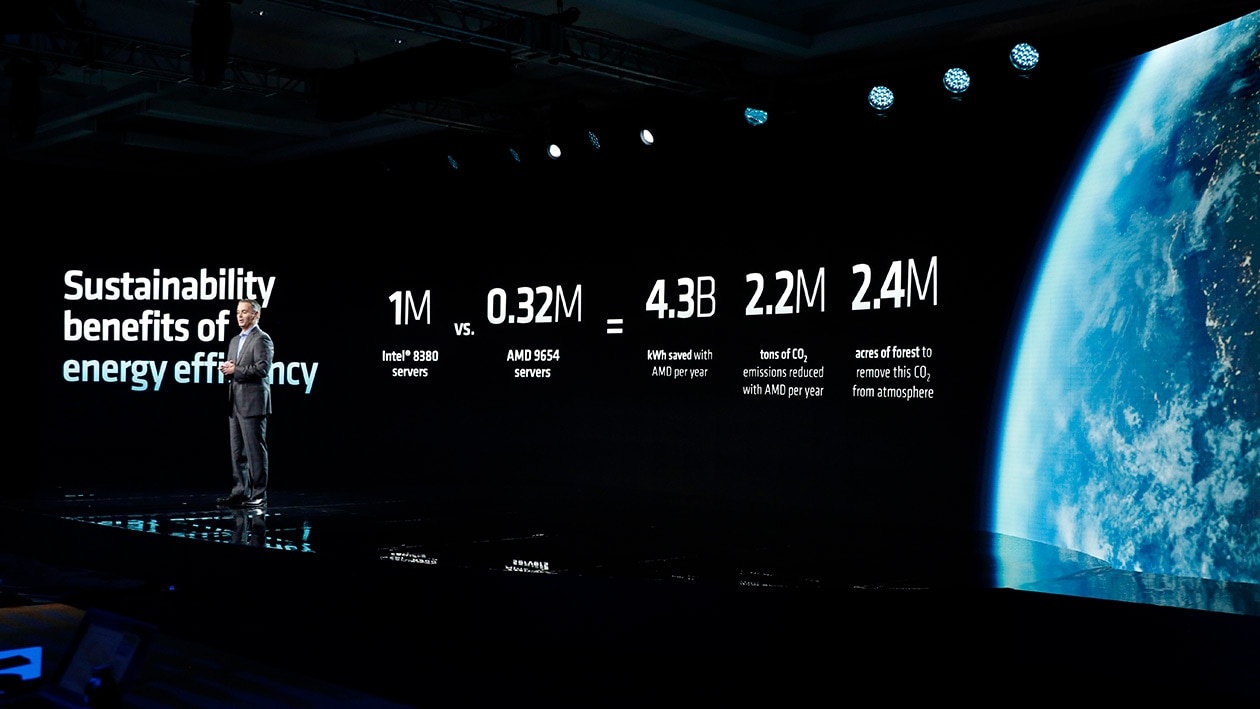4th Gen AMD EPYC™ Processors Help Cut Energy Use — Without Cutting Corners
Nov 17, 2022

Energy efficiency is becoming an increasingly critical business priority, as electricity costs climb. 4th Gen AMD EPYC processors, launched last week, are the latest in the AMD line of server processors designed for performance and efficiency, to help reduce enterprise energy usage, save costs, and help companies meet their data center sustainability goals.
The processor beats the competition for energy efficiency while delivering exceptional performance.
A great example of the 4th Gen EPYC processor’s superior efficiency is in running virtualization workloads— something essential for today’s enterprise apps. As a test, EPYC CPU-powered servers were benchmarked against servers using the fastest available competitive processor, running a workload of around 2000 VMs.

In these tests, AMD EPYC blew the doors off the competition. 15 servers using the competitor’s 2P Intel Platinum 8380 processors were required to run those VMs, while that same work could be done by just five 2P AMD servers with AMD EPYC 9654 processors.
EPYC’s superior efficiency means customers can run workloads on fewer servers, for more energy and cost savings—up to 67% fewer servers, requiring up to 52% less power, reducing CAPEX up to 40% and OPEX up to 61% in the first year.¹
The choice of processor for enterprise servers matters more than ever, whether it’s for a new deployment, like this example, or to refresh servers already in the data center. To modernize and consolidate existing servers, five less efficient legacy servers can be replaced with a single server based on 4th Gen EPYC to get up to 80% consolidation in rack footprint, in addition to up to 58% lower energy costs per year from that consolidation.²

Global Impact
The efficiency benefits can scale globally, too. To measure the potential impact of switching to AMD EPYC processors, consider this:
More than one million servers are expected to be deployed on-premise next year in the US. Imagine if all one million servers were configured with the latest top-of-stack Intel processor. To match the workload computing capacity of those million Intel servers, you’d only need to deploy 318,000 servers based the EPYC processors. Swapping those Intel processors for AMD EPYC would reduce energy consumption by about 4.3 billion kilowatt-hours over the course of just one year. That’s enough to power 400,000 US households every year.
Plus, the reduced server numbers would lower CO2 emissions by 2.2 million tons—an amount of CO2 that would require 2.4 million acres of forest to remove from the atmosphere.³ For context, this is an area of forest larger than Yellowstone national park!
That difference in consumption is staggering, for IT budgets and the environment.

Why This Matters
Businesses need to become more efficient to save energy and money. Commercial energy prices are soaring worldwide – as much as 6x in a year in some European countries.
Data center efficiency has become a business imperative, as data centers now consume 2% of total US energy today. And the demand for data center computing continues to grow.
So it’s no wonder that companies are increasingly prioritizing sustainability, driven by rising energy costs, regulatory requirements, and computing demand. As businesses place greater priority on sustainability, running efficient data centers can help achieve those goals. By deploying servers built with 4th Gen AMD EPYC processors, businesses may be able to reduce power usage—and associated greenhouse gas emissions—and cut costs without reducing computing capability and application workload throughput.
The 4th Gen EPYC processors’ efficiency is the next step of a longstanding commitment.
Hear more from AMD and partners about how 4th Gen AMD EPYC processors can help you run your business critical applications more efficiently: https://www.amd.com/epyc4.
Resources
- SP5TCO-019A: As of 11/15/2022 based on AMD Internal analysis using the AMD EPYC™ Bare Metal Server & Greenhouse Gas Emission TCO Estimation Tool - version 6.40, estimating the cost and quantity of 2P AMD EPYC™ 9654 (96 core/CPU) powered server versus 2P Intel® Xeon® Gold 8380 (40 core/CPU) based server solutions required to deliver 1995 total virtual machines (VM) based on VMmark tiles in published results. Environmental impact estimates made leveraging this data, using the Country / Region specific electricity factors from the '2020 Grid Electricity Emissions Factors v1.4 – September 2020', and the United States Environmental Protection Agency 'Greenhouse Gas Equivalencies Calculator'. This scenario contains many assumptions and estimates and, while based on AMD internal research and best approximations, should be considered an example for information purposes only, and not used as a basis for decision making over actual testing. For additional details, see https://www.amd.com/en/legal/claims/epyc-claims.html#q=SP5TCO-019A.
- SP5TCO-022A: As of 11/15/2022 based on AMD Internal analysis using the AMD EPYC™ Bare Metal Server & Greenhouse Gas Emission TCO Estimation Tool - version 6.40, estimating the cost and quantity of 2P AMD EPYC™ 9654 (96 core/CPU) powered server versus 2P Intel® Xeon® Platinum 8130 (28 core/CPU) based server solutions required to deliver 380 total virtual machines (VM), requiring 1 core and 8GB of memory per VM. Environmental impact estimates made leveraging this data, using the Country / Region specific electricity factors from the '2020 Grid Electricity Emissions Factors v1.4 – September 2020', and the United States Environmental Protection Agency 'Greenhouse Gas Equivalencies Calculator'. This scenario contains many assumptions and estimates and, while based on AMD internal research and best approximations, should be considered an example for information purposes only, and not used as a basis for decision making over actual testing. For additional details, see https://www.amd.com/en/legal/claims/epyc-claims.html#q=SP5TCO-022A.
- SP5TCO-021A: This analysis is a theoretical exercise, made as of 11/15/2022 based on AMD Internal analysis using the AMD EPYC™ Bare Metal Server & Greenhouse Gas Emission TCO Estimation Tool - version 6.40 estimating the cost and quantity of 2P AMD EPYC™ 9654 (96 core/CPU) powered server versus 2P Intel® Xeon® Gold 8380 (40 core/CPU) based server solutions required to deliver 133 million total virtual machines (VM) based on VMmark tiles in published results. Environmental impact estimates made leveraging this data, using the Country / Region specific electricity factors from the '2020 Grid Electricity Emissions Factors v1.4 – September 2020', and the United States Environmental Protection Agency 'Greenhouse Gas Equivalencies Calculator'. This scenario contains many assumptions and estimates and, while based on AMD internal research and best approximations, should be considered an example for information purposes only, and not used as a basis for decision making over actual testing. For additional details, see https://www.amd.com/en/legal/claims/epyc-claims.html#q=SP5TCO-021A.
